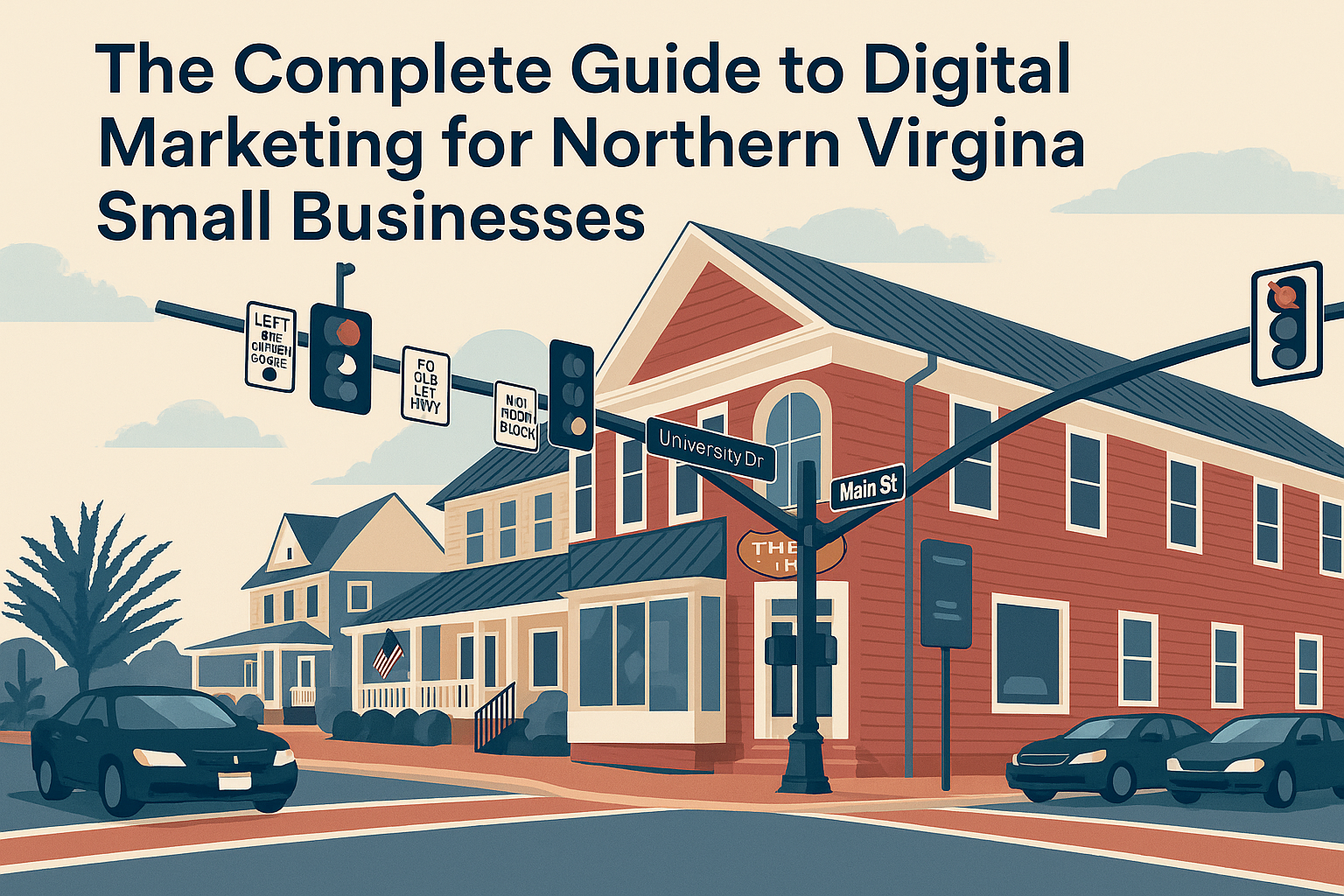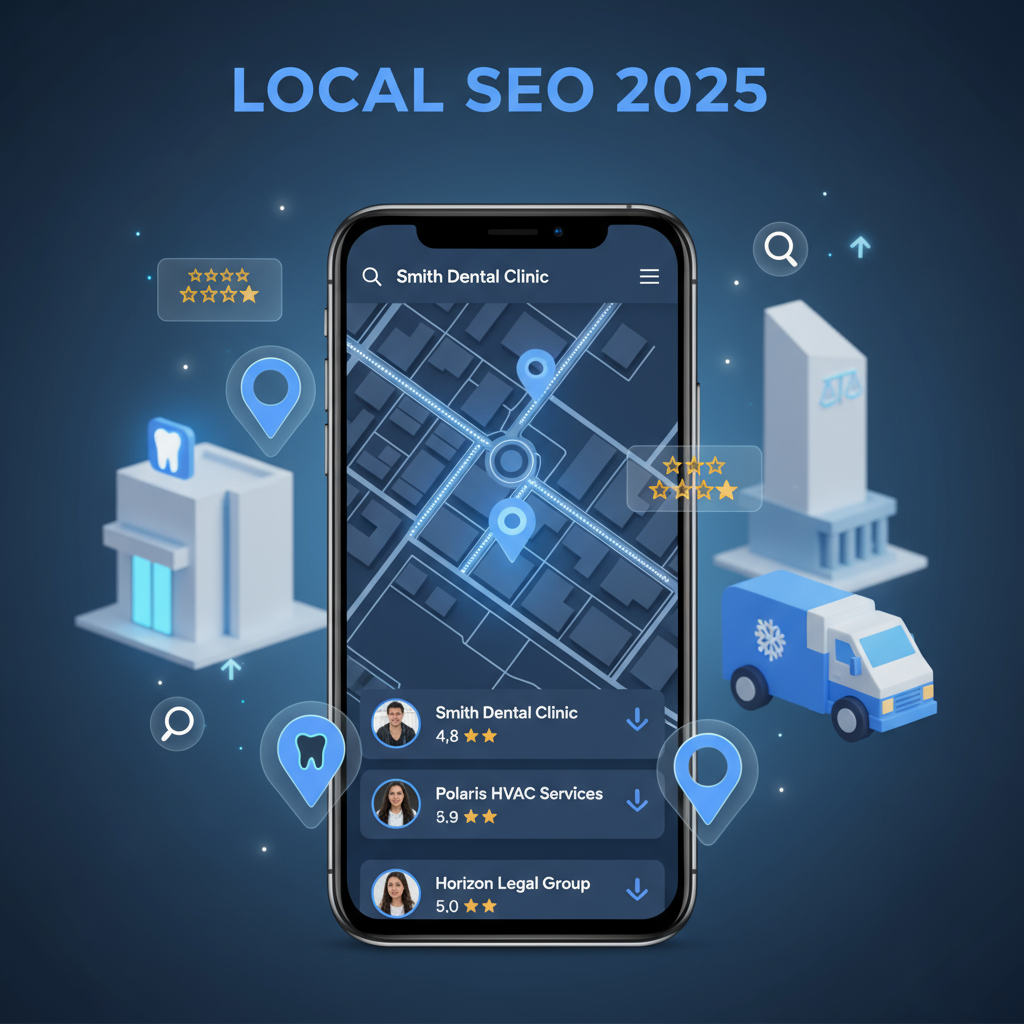
- 1. Introduction: Why Local SEO Matters More Than Ever for Small Businesses
- 2. Understanding Local SEO: What It Is and How It Works
- 3. Google My Business (GMB): Your Local SEO Foundation
- 4. Local Citations and Directory Listings: Building Your Online Presence
- 5. Online Reviews: The Power of Social Proof in Local Search
- 6. Localized Website Content: Speaking to Your Local Audience
- 7. Local Link Building: Earning Authority in Your Community
- 8. Technical SEO for Local Businesses: Ensuring Your Site is Search-Friendly
- 9. Tracking Your Local SEO Success: Key Metrics to Monitor
- 10. Conclusion: Dominate Your Local Market with a Strong SEO Strategy
1. Introduction: Why Local SEO Matters More Than Ever for Small Businesses
In today’s digital-first world, when consumers need a product or service, their first instinct is often to reach for their smartphone and perform a quick online search. For small businesses, especially those with a physical location or a service area, this behavior presents a monumental opportunity. This is where Local SEO (Search Engine Optimization) steps in, acting as the bridge between online searches and offline customer actions. Local SEO is not just about ranking high in general search results; it’s about appearing prominently when potential customers in your immediate vicinity are looking for what you offer. Think about it: when someone searches for “best coffee shop near me” or “plumber in [Your City],” they are typically ready to make a purchase or book a service. By optimizing your online presence for local searches, you can capture this high-intent traffic, drive foot traffic to your store, or generate direct inquiries for your services.
For small businesses, competing with large national or international brands on broad keywords can be an uphill battle. Local SEO levels the playing field, allowing you to target a specific geographic audience that is most likely to convert. It’s about ensuring that when a potential customer in your neighborhood or service area types a query into Google, your business is among the first they see. This guide will walk you through the essential components of a successful Local SEO strategy, providing actionable steps to help your small business not only survive but thrive in the competitive local market. From optimizing your Google My Business profile to leveraging online reviews and building local citations, we’ll cover everything you need to know to dominate local search results and turn online searches into loyal customers.
2. Understanding Local SEO: What It Is and How It Works
Local SEO is a specialized branch of search engine optimization that focuses on improving the visibility of a business in local search results. Unlike traditional SEO, which aims for broad national or global rankings, Local SEO is geographically targeted. Its primary goal is to help businesses appear in the
“Local Pack” (the map results at the top of Google search results), Google Maps, and localized organic search results. This is particularly vital for brick-and-mortar businesses, service area businesses, and any enterprise that relies on local clientele.
Search engines, especially Google, use a variety of signals to determine which businesses to show for local queries. These signals include:
- Proximity: How close the searcher is to the business location.
- Relevance: How well a business matches what the searcher is looking for.
- Prominence: How well-known and authoritative a business is, based on factors like reviews, links, and citations.
Local SEO encompasses a range of tactics designed to optimize these signals. It involves optimizing your Google My Business (GMB) profile, building consistent local citations across various online directories, managing and acquiring online reviews, creating localized content on your website, and ensuring your website is technically sound and mobile-friendly. The goal is to send clear, consistent signals to search engines that your business is a relevant, reputable, and accessible option for local searchers. By mastering these elements, small businesses can significantly increase their chances of being discovered by customers in their immediate vicinity, leading to more calls, website visits, and physical store visits.
3. Google My Business (GMB): Your Local SEO Foundation
Google My Business (GMB) is arguably the single most important tool for local SEO. It’s a free platform provided by Google that allows businesses to manage their online presence across Google Search and Google Maps. An optimized GMB profile acts as your digital storefront, providing potential customers with crucial information at a glance and directly influencing your visibility in the local pack and map results.
3.1. Claiming and Verifying Your GMB Profile
The first step to leveraging GMB is to claim and verify your business listing. If you haven’t already, search for your business on Google Maps. If it appears, you can claim it. If not, you’ll need to create a new listing. Verification typically involves receiving a postcard with a verification code at your business address, though other methods like phone or email verification may be available for some business types. Without verification, your GMB profile will not be fully active, and you won’t be able to manage its information or appear in local search results.
3.2. Optimizing Your GMB Listing for Maximum Impact
Once verified, optimizing your GMB listing is crucial. Every field in your GMB profile is an opportunity to provide more information to Google and potential customers. Key optimization areas include:
- Business Name: Use your exact legal business name. Do not stuff keywords into your business name, as this violates Google’s guidelines and can lead to penalties.
- Address: Ensure your address is accurate and consistent with how it appears elsewhere online.
- Phone Number: Use a local phone number if possible.
- Website: Link to your official business website.
- Categories: Choose the most accurate and specific primary category that describes your business. Then, add relevant secondary categories. This is a critical ranking factor for local search.
- Business Hours: Keep your hours updated, especially for holidays.
- Description: Write a compelling, keyword-rich description of your business, highlighting your unique selling propositions and what makes you stand out.
- Photos and Videos: Upload high-quality photos of your storefront, interior, products, services, and team. Businesses with photos receive more clicks and engagement. Consider adding a virtual tour.
- Services/Products: Clearly list the services or products you offer. This helps Google understand your business better and can appear directly in search results.
3.3. Leveraging GMB Posts and Q&A for Engagement
GMB is not a static profile; it’s an interactive platform. Actively using its features can significantly boost your local SEO:
- Google Posts: Regularly publish
Google Posts to share updates, offers, events, and new content. These posts appear directly in your GMB profile and can drive engagement and traffic.
* Q&A Section: Monitor and answer questions in the Q&A section. This is a public forum where anyone can ask questions about your business. Providing timely and helpful answers demonstrates excellent customer service and can influence potential customers.
4. Local Citations and Directory Listings: Building Your Online Presence
Local citations are online mentions of your business’s name, address, and phone number (NAP). These can be structured (e.g., listings on Yelp, Yellow Pages, Facebook) or unstructured (e.g., mentions in blog posts or news articles). Consistency across all your NAP citations is a critical ranking factor for local SEO. Inconsistent information can confuse search engines and negatively impact your local search rankings.
4.1. The Importance of NAP Consistency
Search engines cross-reference your business information across various online sources to verify its accuracy and legitimacy. If your business name, address, or phone number varies from one listing to another, it can erode trust and make it harder for search engines to confidently display your business in local search results. Ensure your NAP details are identical everywhere they appear online, down to the smallest detail (e.g., “St.” vs. “Street,” suite numbers).
4.2. Key Local Directories and Niche Platforms
Beyond Google My Business, there are numerous other directories where your business should be listed. These include:
- Major Data Aggregators: Services like Factual, Infogroup, and Acxiom distribute business information to a vast network of online directories and platforms. Ensuring your data is accurate with these aggregators can help propagate correct information across the web.
- General Business Directories: Yelp, Yellow Pages, Facebook, Apple Maps, Bing Places, and Foursquare are essential platforms for local businesses.
- Industry-Specific Directories: Depending on your business type, there may be niche directories relevant to your industry (e.g., Healthgrades for healthcare, Avvo for legal, HomeAdvisor for home services). Listing your business in these specialized directories can provide highly relevant local links and attract targeted customers.
- Local Chamber of Commerce and Business Associations: Membership in local business organizations often comes with a listing on their website, providing a valuable local citation and potential backlink.
4.3. Auditing and Cleaning Up Citations
It’s not enough to just create new citations; you must also manage existing ones. Over time, inconsistencies can creep in due to business changes, data entry errors, or mergers. Regularly auditing your citations is crucial to identify and correct any discrepancies. Tools are available (many SEO platforms offer citation auditing features) that can help you find existing citations and highlight inconsistencies. Cleaning up these errors ensures that search engines receive clear and consistent signals about your business, reinforcing your local presence.
5. Online Reviews: The Power of Social Proof in Local Search
Online reviews are a cornerstone of local SEO, influencing both search engine rankings and consumer decision-making. Positive reviews signal to search engines that your business is reputable and trustworthy, while also providing social proof that encourages potential customers to choose your services. The quantity, quality, and recency of reviews all play a role in your local search performance.
5.1. Encouraging and Managing Customer Reviews
Proactively encouraging satisfied customers to leave reviews is essential. Here are some strategies:
- Directly Ask: Don’t be shy! Politely ask happy customers to leave a review on Google, Yelp, or other relevant platforms. Provide them with direct links to make the process easy.
- Email Campaigns: Send follow-up emails after a service or purchase, including a clear call to action and links to review sites.
- In-Store Signage/Cards: Display signs or hand out cards with QR codes that link directly to your review profiles.
- Website Integration: Embed review widgets or links on your website to encourage submissions.
- Avoid Incentives: Do not offer incentives for positive reviews, as this violates Google’s guidelines and can lead to penalties.
5.2. Responding to Reviews: Best Practices
Responding to all reviews, both positive and negative, demonstrates that you value customer feedback and are actively engaged with your online reputation.
- For Positive Reviews: Thank the customer, mention their name (if appropriate), and reiterate something specific they praised. This shows genuine appreciation.
- For Negative Reviews: Respond promptly, professionally, and empathetically. Acknowledge their concerns, apologize for any negative experience, and offer to take the conversation offline to resolve the issue. Never get into a public argument. A well-handled negative review can turn a bad experience into a positive perception of your customer service.
5.3. The Impact of Review Quantity and Quality on Local Rankings
Search engines consider both the number of reviews and their average star rating when determining local search rankings. Businesses with more positive reviews tend to rank higher. Furthermore, the keywords used within reviews can also influence rankings, as search engines analyze review content for relevance. Regularly acquiring new reviews also signals to search engines that your business is active and relevant.
6. Localized Website Content: Speaking to Your Local Audience
While GMB and citations are crucial, your website also plays a significant role in local SEO. By creating localized content, you can signal to search engines that your business is relevant to specific geographic areas and directly address the needs of your local audience.
6.1. Creating Location-Specific Landing Pages
If your business serves multiple locations or specific service areas, creating dedicated landing pages for each location is highly effective. These pages should:
- Be Unique: Each page should have unique, high-quality content that is not duplicated from other location pages.
- Include Local Keywords: Naturally integrate the city, state, or neighborhood names into the page title, headings, body text, and meta description.
- Provide Local Information: Include local testimonials, photos of local landmarks (if relevant), specific services offered in that area, and local contact information.
- Embed a Local Map: Include an embedded Google Map of your business location or service area.
6.2. Optimizing for “Near Me” Searches
The rise of mobile search has led to an increase in “near me” queries (e.g., “dentist near me,” “pizza near me”). To optimize for these searches, ensure your website content naturally incorporates phrases that indicate proximity or local intent. This includes using location-specific keywords throughout your content and ensuring your GMB profile is fully optimized, as Google often pulls information from GMB for “near me” results.
6.3. Integrating Local Keywords Naturally
Beyond dedicated landing pages, integrate local keywords naturally throughout your website content, including blog posts, service pages, and your About Us section. For example, if you’re a plumber in Fairfax, VA, your content might discuss “plumbing services in Fairfax” or “emergency plumbing in Northern Virginia.” Avoid keyword stuffing, as this can harm your rankings. The goal is to provide valuable, informative content that genuinely serves your local audience.
7. Local Link Building: Earning Authority in Your Community
Just like traditional SEO, local SEO benefits significantly from high-quality backlinks. However, for local SEO, the emphasis is on acquiring links from locally relevant and authoritative websites. These links signal to search engines that your business is an important part of the local community.
7.1. Partnering with Local Businesses and Organizations
Collaborate with other local businesses, non-profits, or community organizations. This could involve:
- Cross-Promotions: Partnering on events or marketing campaigns that result in mutual mentions and links on each other’s websites.
- Sponsorships: Sponsoring local sports teams, school events, or community charities often comes with a mention and a link on their website.
- Local Associations: Joining local business associations or chambers of commerce can provide opportunities for directory listings and links.
7.2. Sponsoring Local Events and Charities
Beyond direct partnerships, actively participating in and sponsoring local events or charities can generate valuable local links. When your business sponsors an event, it’s common for the event’s website to list its sponsors, often with a link back to your site. This not only helps your local SEO but also enhances your brand’s reputation within the community.
7.3. Engaging with Local Media
Seek opportunities for local press coverage. If you have a unique story, a new service, or are involved in a community initiative, reach out to local newspapers, online news sites, or local bloggers. Media mentions often include links back to your website, providing powerful local authority signals.
8. Technical SEO for Local Businesses: Ensuring Your Site is Search-Friendly
Technical SEO ensures that your website is crawlable, indexable, and provides a good user experience, which are all foundational for local SEO success. Even the best local content won’t rank if search engines can’t properly access and understand your site.
8.1. Mobile-Friendliness and Responsive Design
Given that a significant portion of local searches occur on mobile devices, your website must be mobile-friendly. A responsive design ensures your site adapts seamlessly to any screen size, providing an optimal viewing and interaction experience for users on smartphones and tablets. Google’s mobile-first indexing means the mobile version of your site is primarily used for ranking.
8.2. Site Speed and Core Web Vitals
Page load speed is a critical ranking factor and directly impacts user experience. Slow websites lead to higher bounce rates. Optimize images, leverage browser caching, minify code, and use a Content Delivery Network (CDN) to ensure your site loads quickly. Pay attention to Google’s Core Web Vitals (Largest Contentful Paint, First Input Delay, Cumulative Layout Shift) as these measure real-world user experience and are increasingly important for rankings.
8.3. Implementing Local Business Schema Markup
Schema markup (structured data) helps search engines understand the context of your content. For local businesses, implementing LocalBusiness schema is crucial. This markup provides search engines with explicit details about your business, such as name, address, phone number, opening hours, services, and reviews. This can lead to rich snippets in search results, making your listing stand out and potentially increasing click-through rates.
9. Tracking Your Local SEO Success: Key Metrics to Monitor
To ensure your Local SEO efforts are yielding results, it’s essential to track key metrics regularly. This allows you to identify what’s working, what’s not, and where to adjust your strategy.
- Google My Business Insights: Monitor views, searches, and customer actions (calls, website visits, direction requests) directly within your GMB dashboard.
- Organic Traffic (Segmented by Location): Use Google Analytics to track organic traffic specifically from your target local areas.
- Local Keyword Rankings: Monitor your business’s ranking for local keywords (e.g., “[service] in [city]”).
- Website Conversions: Track how many local visitors complete desired actions on your website (e.g., fill out a contact form, make a phone call).
- Online Review Growth and Average Rating: Keep an eye on the number of new reviews and your overall star rating across platforms.
10. Conclusion: Dominate Your Local Market with a Strong SEO Strategy
Local SEO is a powerful tool for small businesses looking to connect with customers in their immediate vicinity. By systematically optimizing your Google My Business profile, building consistent local citations, actively managing online reviews, creating localized website content, engaging in local link building, and ensuring your site is technically sound, you can significantly enhance your visibility in local search results. This comprehensive approach will not only drive more qualified local traffic to your business but also establish your authority and trustworthiness within your community. Invest in Local SEO, and watch your small business thrive in the local market.




